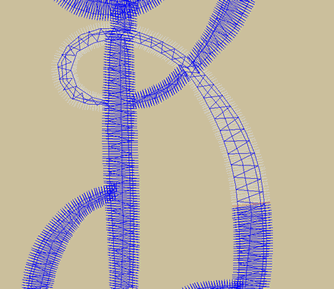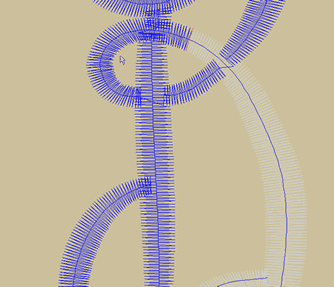|
FAQ
Anatomy of a Knock-off
After more than ten years specializing in designs for monogramming, it’s probably inevitable that what we introduce begins to show up for sale as illegal copies or as imitations of our monogram styles.
Our License Agreement allows the purchaser to use our designs for commercial purposes, but not to sell copies of the designs themselves. US and International Copyright Law protects intellectual property rights, and we have had positive cooperation from Ebay in removing suspect auctions worldwide.
It’s a bit more complicated to control the knock-off - a recreated style that looks basically the same as the original. Knock-offs occur in cars, furniture, food… and embroidery designs.
We recently came across a good example. This article is an attempt to educate embroidery machine owners on what to watch for in a knock-off design.

At first glance, these two designs appear to be identical - one-color satin stitch letters. But look closer ... the knock-off letter B is on the left, from a set called “Frenchie”. The letter B from our Empire Monogram Set is on the right.
Although both designs are the same size, the first noticeable difference between these seemingly matching letters is the stitch count. The knock-off has 2,520 stitches. Ours has 3,085 stitches.
What difference does 565 stitches make?
Underlay
Underlay stitches are created by the digitizer to give stability to an embroidery design - think of them as a framework upon which the finished structure is built. Like a house, a well-digitized embroidery design has a proper foundation. Underlay stabilizes the fabric to avoid distortion as the design sews, but also provides strength and durability to the design over time. This is particularly important for monogram designs, which are typically subjected to repeated washings.
There are different types of underlay - for monogram designs each variation has advantages and disadvantages for different letter sizes and uses. Small letters - one inch or smaller - with very thin column details may be good candidates for a single center running stitch underlay. Larger letters, and particularly those that are composed of wider satin stitch columns that flow in a script style are candidates for more complex and substantial underlay.

Our letter uses three underlay types in combination.
* First, a central running stitch, which functions as the “spine” of the letter.
* Next, an “edge-walk” - an additional running stitch that follows the outline of the column shape, but set in approximately .5 mm from the edge. This running stitch provides additional structure to the finished edge, and ensures that the final satin stitching will be smooth and elegant, rather than jagged, which can easily happen with inadequate underlay.
* Finally, an open column stitch of approximately 10% density. This underlay run ties the rest of the underlay structure together and also gives the finished satin stitch a luxurious rounded quality.


The knock-off letter has one run of center underlay ...... that’s all. In addition, the underlay stitches are impossibly short and too close together - the distance between these stitches is only 1 mm !! Underlay stitches that are too short provide almost no structural support for the design because they completely fall into the fabric. Used on terrycloth they will also tend to cause bunching and sewing problems.
Our underlay stitches are all nearly 3 times longer, insuring that they will not disappear into the fabric, and will do the job they were intended for - creating a high-quality sewout that is strong and stable, and that sews smoothly. We also know that many of our customers will be using these designs on terrycloth towels, so the extra underlay has the added benefit of helping to control the terrycloth loops.
Lock Stitches
A lock stitch is small group of several stitches, close together and crossing each other. For machine embroidery a design should always start with a lock stitch - without it the running stitch underlay will pull out as the machine sews away from the starting point of the design. At the very end of the design another lock stitch is digitized to insure that the last stitch in the finished satin stitch column is anchored and won’t pull out with use and unravel the column. Our letter includes both of these features, typical in high-quality digitizing.
The knock-off has no first lock stitch, so the beginning of the already inadequate running stitch underlay pulls out at the beginning of the sewout. At the end of the design there is an extra little “chunk” of satin stitch - unlikely to function well as a lock stitch over time.
Density
The densities of the satin stitch columns in each example look similar on screen, but when the two letters are sewn out the shortcuts in the knock-off version become evident.
Because the underlay is inadequate the edges of the letter are more jagged and uneven, and the fabric shows through the satin stitches. If sewn on terrycloth the loops of the fabric will be popping through in no time - probably even before the monogram is laundered.
The overall design has a flat appearance, lacking the rounded quality of our digitized letter. One of the best features of a well-digitized satin stitch design is its ability to reflect light differently from the surface of the embroidery.
Traditional monograms were hand stitched by highly skilled embroiderers, and have lots of underlay structure, which adds to the quality of the work - this is monogramming that inspires us, and we feel strongly that our more than ten years experience digitizing monogram designs gives us a thorough understanding of the details that are important in a monogram digitized for a computerized embroidery machine.
What difference does all this make?
As the embroiderer, and our customer, if you care about the quality of your work: a great deal. If all you’re interested in is how much the designs cost, then probably not much. Knock-offs tend to be cheaper by definition.
You don’t need to take our word for all this - download a FREE SAMPLE - sew it out and draw your own conclusions.
Feedback or Questions about "Anatomy of a Knock-Off" (1)
Occasionally, I have purchased letters from other sites to accomplish a particular design...only because you may not offer the particular lettering I need...
...and, almost always,I end up having to go to a professional digitizer to "clean" up the letters...because they are so poor..
Your letters are perfect...from underlay to execution...I don't even have to run a "test copy." I know it will come out perfect the first time and every time.
You are the gold standard in this industry...
Thank you for your wonderful work!!
Elizabeth L. Jarvis
--Posted by: Elizabeth Jarvis
| 
